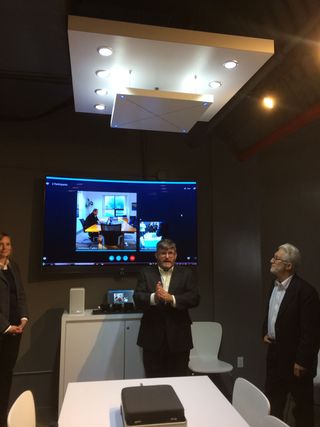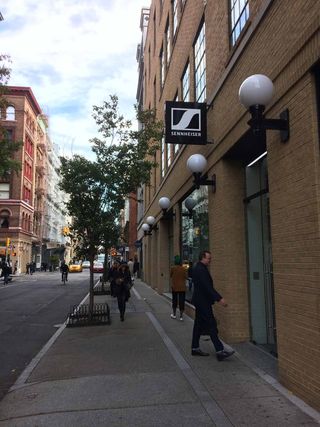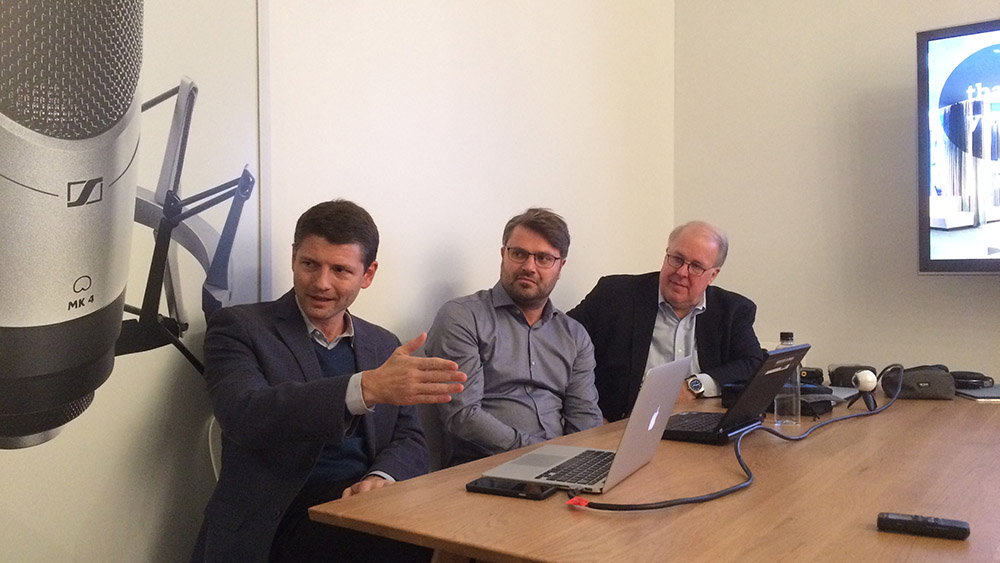It’s wonderful: with a few taps and swipes on a pocket-sized device, we can do just about anything—talk face to face with a friend on the other side of the world, show vacation photos on a TV on the wall, or fill an entire home with music. And it’s all so easy and intuitive, even a small child can figure it out.

Sennheiser’s Charlie Jones (center) led a demonstration of the TeamConnect Ceiling microphone.
But these fantastic conveniences are causing some headaches for integrators, consultants, and designers of commercial AV systems: end users now expect their workplace equipment to have the functionality and intuitiveness of their latest-and-greatest personal devices. How can you design a professional system that meets these expectations? One option is to build a kind of environment that simply embraces them.
“These are humbling realities for the communities of designers that used to pride themselves on custom solutions for things like conference rooms,” said Rob Badenoch, associate principal at TAD Associates, an audiovisual and media design firm based in New York. “And it’s true as well for theaters and production facilities. These consumer devices have to be put into these contexts that are unusual for them, at best. And that’s the next trend: we call it the intrusion of consumer devices into commercial spaces.”
This topic was one of the key trends covered last week at a panel discussion titled “The Future of the Workplace,” held at Sennheiser’s newly opened pop-up store in SoHo.
Along with a small group of AV designers, consultants, and end users, I received a tour of the new facility, which included a dedicated room for demonstrating the company’s new conferencing microphone solutions. In a space made to simulate a small corporate boardroom, Charlie Jones, Sennheiser’s corporate account sales manager, meeting environments, conducted a videoconference with members in the company’s Connecticut offices. On both ends, a TeamConnect Ceiling microphone—essentially a ceiling tile-sized device suspended above the center of the room—provided even and consistent audio as the presenters in Connecticut moved about their room, whether they were speaking directly toward or away from the microphone array.

Panelists, from L to R: Rob Badenoch, TAD Associates; Andy Niemann, Sennheiser; Greg Harper, Neuehouse.After this demonstration, we were seated for the panel discussion, which began by covering the evolution of office design that has made flexible, adaptive solutions like Sennheiser’s TeamConnect suite necessary.
Greg Harper, chief technology officer of Neuehouse, led off with a presentation on the evolution of office design philosophies up to the current trend of open floor plans with small collaborative (or huddle) spaces. He then demonstrated how he has gone about outfitting this kind of environment by example of Neuehouse, an membership-based, “airline club”-like shared workspace and collaboration facility with locations in Manhattan and Los Angeles.
“Basically today, to be connected, all we really need is a connection screen—that can be a laptop, a phone, or a tablet—but we still need audio to collaborate,” Harper said. “We all worry about the video, but in fact audio is probably the more important part.”
What makes audio a more important factor, he explained, is because today’s open floor plans, like the core areas at Neuehouse, involve people working on different things in close proximity. To prevent this from becoming a productivity-robbing distraction involves careful acoustic design, as well as users having a good pair of noise-cancelling headphones.
“Really high-quality audio is really important for business communications,” Harper said. “There are times you want to just go into an office and close the door, but you can’t do that; there’s no more door to close. So having something you can put on your head that will do that, and will actually sound good, is important.”

Sennheiser’s new pop-up store on 134 Prince Street in SoHo.As for his personal choice of headphones, Harper extolled his Sennheiser MB 660 UC MS model of wireless, Skype for Business-certified noise cancelling cans, as an ideal solution for conducting calls in close proximity to others—as well as for uninterrupted relaxation with entertainment.
After Harper, Badenoch offered his insights into challenges design firms are facing with regard to equipping workspaces with technology. In addition to the aforementioned issue of delivering solutions that stand up to end users’ lofty expectations, another major struggle is specifying systems that can accommodate the protean nature of technological development.
“It requires that we as designers be mindful of the new set of issues,” Badenoch said. “We have to be concerned with what’s next: none of us on the design side predicted Facebook or the internet, and how radically that would change communication and collaboration in the workplace. The question of consumer electronics is one of volatility, and the issue of not knowing what’s next factors into our infrastructure design. We have to design spaces that can accommodate not just day one of technology outfitting, but day two and beyond.”
While doing this, he stressed, it’s important to consider the distinct lifecycles of a facility. The building itself will be refreshed roughly every 50 years; its furniture, every 15, or so; and the AV technology, every five. The lesson: make sure your AV designs aren’t permanently integrated into the building structure or the furniture. This philosophy, he explained, further motivates the installation of more wireless, BYOD-based systems, and less custom-engineered solutions.
Following an explanation of some of the ways his firm TAD Associates has been diversifying its offerings, such as in the form of managed services that aim to maintain ongoing relationships with end users, Badenoch passed the discussion on to the final presenter, Andy Niemann, Sennheiser’s director of business communication.
Tying together the subjects of consumerization, BYOD, and the challenges of open floor plan designs, Niemann discussed how the products in Sennheiser’s TeamConnect line are designed to provide solutions for nearly every situation. From the boardroom (or huddle room)-optimized TeamConnect Ceiling, which uses 29 mic capsules to form a beam that follows a speaker around the room, to the TeamConnect wireless, which is designed for on-the-go meetings or use in open, collaborative office layouts, the company is positioning itself as a serious new entrant into the commercial unified communications market.














